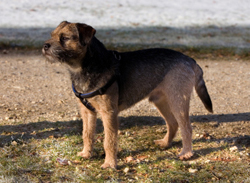Border Terriers are adorable dogs with very wiry, close-fitting coats that may be grizzle and tan, red, blue and tan, or wheaten in color. Their coat is weather resistant with a short and dense undercoat and a somewhat broken topcoat. There is no curl or wave. These dogs are narrow in shoulder, body, and quarter, and they have muscular necks and thick, loose skin. Their eyes are dark hazel, and their muzzles are short and dark. Border Terriers weigh 11.5 to 15.5 pounds and generally live up to 14 years with proper care.
Border Terriers now work in children's hospitals, nursing homes, and as hearing dogs. They also participate in a number of dog sports.
These dogs are highly trainable and affectionate and are more laid-back than other terriers. Plus, they are great watchdogs and companions, making them ideal pets for most families. They are especially good choices for moderately active families with children.
Because of their head shape and whiskers, these little dogs look very much like otters.
Border Terriers are affectionate and good-tempered dogs that make great companion animals for people of all ages. They are good with cats, dogs, and children, but these dogs are not a good choice for families with pet rodents. The self-reliant, friendly, and independent nature of these dogs means they are easy and fun to share a home with.
The Border Terrier's natural feistiness should not be confused with aggression. These dogs love life, and it shows. They are inquisitive creatures that enjoy exploring everything in their environment.
Border Terriers need daily activity in the form of walks, games, and general physical exercise. To remain happy, they must be kept exercised and engaged. These active dogs love chasing small animals and will become noisy if neglected or allowed to become bored. They enjoy roughhousing with children and like to smell everything when on walks. Although Border Terriers appreciate time outdoors, they are inside dogs that should live in the home with their human family.
Although they are a healthy breed overall, Border Terriers are more prone to certain health conditions than some other breeds. Congenital hip dysplasia is fairly common in this breed, and Border Terriers are known to be at increased risk for certain heart defects.
This breed is also affected by canine epileptoid cramping syndrome, a potentially serious seizure-like disorder that is often confused with epilepsy. Unfortunately, there are currently no screening tests for this genetic disorder, but there are research projects underway to develop one. Carefully reviewing the family line of puppies before purchase or adoption can help determine which dogs are at risk for this disease.
With proper nutrition, regular exercise, routine veterinary care, and timely vaccinations, Border Terriers usually live 12 to 14 years.
Intelligent and biddable dogs, Border Terriers learn quickly and respond well to obedience training. They are very rarely defiant and adapt well to most training methods and environments. Positive reinforcement and praise ensure the best results.
These dogs will roam if given the opportunity, and this can put them in harm's way. They must be walked on a leash or confined to a securely fenced yard or play area when outdoors. It's important to note that Border Terriers are highly skilled at escaping even the most fortified of fences. Additional security measures may be necessary to contain these dogs, and fence lines should be checked frequently for holes or other signs of escape paths.
If ignored, these dogs will find a way to get into trouble. They especially enjoy digging and barking, and they can tear up a yard and annoy neighbors very quickly. They need time in the house as well as the yard, and they should never be left alone for long periods.
The Border Terrier's coat is weather-resistant and wiry. Although it needs only occasional brushing, it requires hand stripping at least twice each year. Brushing or combing it weekly will reduce loose hair and keep it off furniture and clothing.
Dogs that will be shown can benefit from a quick trim of the neck, head, and feet to tidy their appearance. Stripping the coat will result in a less scruffy look. First-time dog owners may need a professional groomer to perform these tasks.
The nails should be trimmed every few weeks, and the ears should be checked every week or so for signs of infection. If redness, odor, discharge, or heavy wax accumulation appear, a veterinarian must be consulted. The teeth need brushing regularly to freshen breath and prevent gum and tooth problems.
Border Terriers originated in the border area between Scotland and England, and they are one of the oldest terriers in Great Britain. They were developed in the 1700s and bred to protect stock. Their bodies were flexible and long, which made them perfect for squeezing into narrow fox dens.
The breed was prized because it was fast enough to follow horses, but small enough to follow a fox to ground. When used as farm dogs during the 18th century, Border Terriers had to hunt for their own food in order to survive. This turned them into above-average hunters.
These dogs have changed very little over the years, certainly less than most other breeds. Border Terriers now work in children's hospitals, nursing homes, and as hearing dogs. They also participate in a number of dog sports.
The American Kennel Club officially recognized the Border Terrier in 1930.

